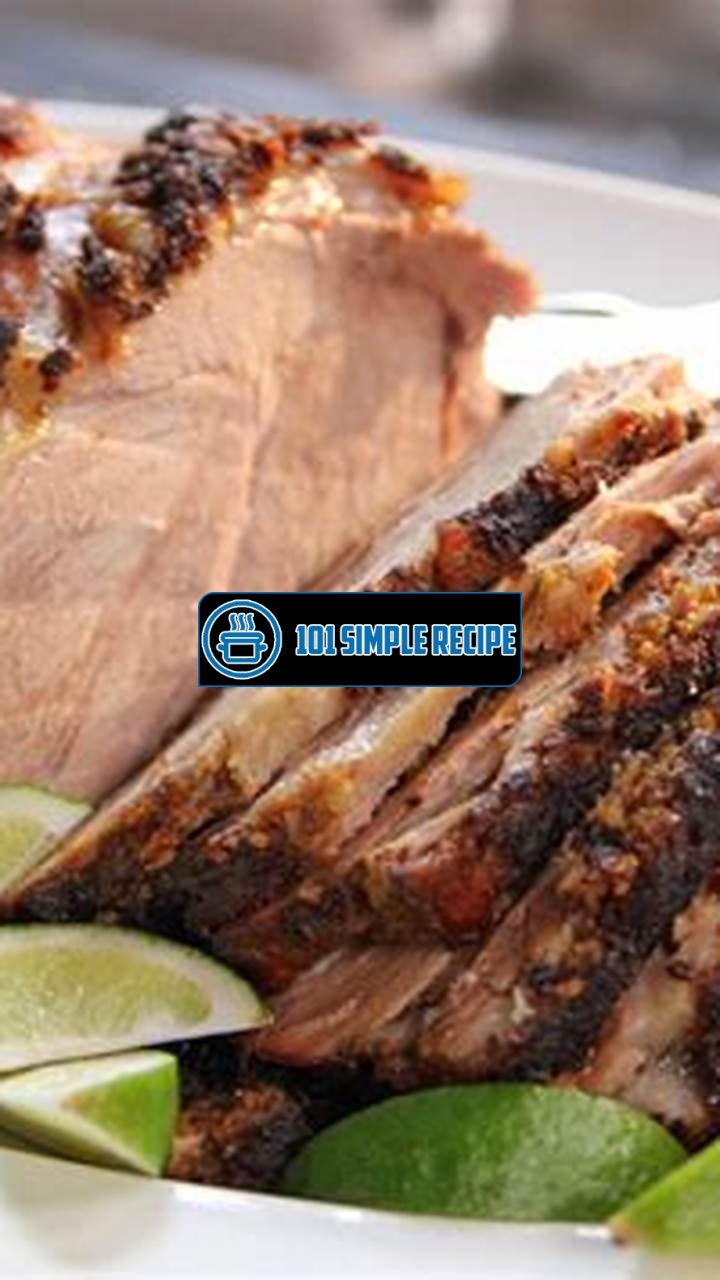Looking for delicious and healthy roast pork recipes? Look no further! We’ve got you covered with a variety of mouthwatering dishes that are both flavorful and nutritious. Whether you’re a meat lover or simply looking to add some variety to your dinner menu, these recipes are sure to impress. From succulent herb-roasted pork tenderloin to savory garlic and rosemary roasted pork loin, there’s something to satisfy every palate. So, roll up your sleeves, put on your chef’s hat, and get ready to indulge in the tantalizing aroma and incredible taste of these delectable roast pork recipes. ✨

The Health Benefits of Roast Pork
Discover the numerous health benefits of incorporating roast pork into your diet.
Nutritional Value of Roast Pork
Roast pork is not only delicious, but it also offers a wide range of important nutrients that contribute to a healthy diet. One of the key nutrients found in roast pork is protein. Protein plays a crucial role in building and repairing tissues in the body, making it an essential part of any diet. A 3-ounce serving of roast pork contains approximately 22 grams of protein, which is equivalent to almost half of the recommended daily intake for an average person.
Roast pork also provides essential vitamins and minerals. It is a rich source of B vitamins, including thiamine, niacin, and riboflavin, which are important for energy production and a healthy metabolism. Additionally, roast pork contains essential minerals like iron, zinc, and selenium, which are vital for various functions in the body, including immunity, growth, and development.
Incorporating roast pork into your diet can also help fulfill your daily requirement of dietary fats. While it’s important to consume fats in moderation, roast pork provides a balance of saturated and unsaturated fats, which are necessary for optimal health. These healthy fats support hormone production, protect vital organs, and aid in the absorption of fat-soluble vitamins.
Lean Cuts of Pork for Healthy Roasting
To ensure that your roast pork recipes are healthy and nutritious, it is important to choose lean cuts of pork. Opt for cuts such as tenderloin, loin chops, or sirloin roast, which are generally lower in fat compared to fattier cuts like pork belly or shoulder. By using lean cuts, you can enjoy the health benefits of roast pork without consuming excessive amounts of saturated fat.
When preparing lean cuts of pork, trim off any visible fat before cooking to further reduce the fat content. This will help create a leaner and healthier final dish. Alternatively, you can marinate the meat in flavorful herbs and spices to enhance the taste without adding unnecessary fats.
Roasting is a healthy cooking method for pork as it allows the excess fat to drip away while maintaining the meat’s tenderness and juiciness. By using lean cuts of pork and roasting them, you can indulge in delicious and satisfying meals while keeping your dietary goals in check.
Protein-rich and Satisfying
Roast pork is an excellent source of protein, making it a satisfying addition to your meals. Protein helps you feel fuller for longer, which can aid in weight management and prevent overeating. Additionally, protein plays a crucial role in muscle recovery and growth, making roast pork an ideal choice for individuals who lead an active lifestyle or engage in regular exercise.
The combination of protein and other essential nutrients found in roast pork makes it a nutritious option for promoting overall health and well-being. Whether you’re looking to build muscle, maintain a healthy weight, or simply enjoy a delicious and satisfying meal, roast pork offers a myriad of benefits that make it a standout ingredient in a balanced diet.
Roast pork is not only a flavorful and versatile meat option but also a nutritious one. From its high protein content to its abundance of essential vitamins and minerals, roast pork deserves a place on your plate. By choosing lean cuts and incorporating it into your meals, you can enjoy the health benefits and delicious flavors of roast pork while nourishing your body.
Looking for more great recipes? Try our roast pork recipes for a variety of flavorful options.
Choosing and Preparing the Perfect Cut of Pork
When it comes to preparing a delicious and healthy roast pork dish, selecting the right cut of pork is essential. By choosing the right cut, you can ensure a tender and flavorful roast. Here are some tips to help you in selecting and preparing the perfect cut of pork for your roast.
Understanding Different Pork Cuts
Before you head to the grocery store, it’s important to understand the different cuts of pork available. Each cut has unique characteristics that can affect the taste and texture of your roast.
- Pork loin: This cut is lean and tender, making it an excellent choice for roasting. It is typically sold boneless or bone-in and can be roasted whole or cut into chops.
- Pork shoulder: Also known as pork butt or Boston butt, this cut is well-marbled and flavorful. It is perfect for slow-cooking and roasting to produce a tender and juicy roast.
- Pork tenderloin: The tenderloin is a small, lean cut that cooks quickly and is great for roasting. It is long and cylindrical in shape and can be seasoned and roasted whole or cut into medallions.
By understanding the different cuts of pork, you can choose the one that best suits your taste preferences and cooking method.
Tips for Trimming the Fat
While some fat is necessary for flavor and moisture, it’s important to trim excess fat from the pork before roasting. Here are some tips for trimming the fat:
- Use a sharp knife: A sharp knife will make it easier to trim the fat from the pork. Trim any large, visible pieces of fat, leaving a thin layer for flavor.
- Remove any silver skin: Silver skin is a tough membrane that can make the pork chewy. Use your knife to carefully remove any silver skin from the surface of the meat.
- Consider brining: Brining involves soaking the pork in a mixture of salt, sugar, and water to enhance its moisture and flavor. This can help tenderize the meat and reduce the need for excessive fat.
By trimming the fat from your pork roast, you can create a healthier dish without sacrificing flavor.
Marinades and Seasonings for Flavorful Roasts
To elevate the flavor of your roast pork, consider using marinades and seasonings. These can add depth and complexity to your dish. Here are some ideas to get you started:
1. Asian-inspired marinade: Combine soy sauce, ginger, garlic, and honey for a savory and slightly sweet flavor profile.
2. Herb rub: Create a blend of your favorite herbs, such as rosemary, thyme, and sage, mixed with olive oil to create a fragrant and aromatic crust.
3. Citrus marinade: Squeeze fresh lemon or orange juice over the pork and season with herbs and spices for a tangy and zesty taste.
Don’t be afraid to experiment with different marinades and seasonings to find your favorite combination. The key is to let the flavors develop by marinating the pork for several hours or overnight before roasting.
By following these tips for choosing and preparing the perfect cut of pork, you can create delicious and healthy roast pork recipes that will impress your family and friends. So next time you’re in the mood for a succulent roast, remember to select the right cut, trim the fat, and add flavorful marinades and seasonings. Enjoy!
If you’re looking to lose weight, you might want to try our weight loss recipes.
Healthier Roasting Techniques for Pork
When it comes to roast pork, it’s important to strike a balance between mouthwatering flavor and healthy choices. Fortunately, there are several alternative roasting methods that can help reduce the fat content while still delivering a delicious culinary experience. Whether you prefer a low and slow approach, a smoky grilled flavor, or a moist and tender result through braising, these techniques are sure to satisfy your cravings.
Low and Slow Roasting
If you’re looking for a tender and juicy roast pork, the low and slow method is an excellent choice. This technique involves cooking the pork at a lower temperature for a longer period of time, allowing the meat to become fork-tender while retaining its natural flavors.
One way to achieve low and slow roasting is by using a slow cooker or crockpot. Simply season your pork with your favorite herbs and spices, place it in the slow cooker, and let it cook on low heat for several hours. This method guarantees a moist and succulent result, as the pork slowly cooks in its own juices.
An important tip to remember when using the low and slow method is to avoid removing the lid of the slow cooker while the pork is cooking. This helps preserve the moisture and ensure an evenly cooked roast.
Grilling for a Smoky Flavor
If you’re a fan of the smoky and charred taste that comes from grilling, then this method will be perfect for you. Grilling pork adds a unique depth of flavor while allowing excess fat to drip away, resulting in a healthier yet incredibly delicious roast.
Start by marinating your pork in your favorite mix of herbs, spices, and a touch of oil for added moisture. Preheat your grill to a medium-high heat and place the pork on the grates. Cook each side for about 5-10 minutes, or until the internal temperature reaches a safe 145°F.
To enhance the smoky flavor, you can also add wood chips or chunks soaked in water to your grill. This adds a delightful aroma and infusion of smokiness to your roast pork.
Braising for Moist and Tender Pork
When it comes to achieving a moist and tender roast pork, braising is the way to go. This method involves cooking the pork in a liquid, such as broth or wine, for an extended period of time. The result is a melt-in-your-mouth texture and a burst of flavor in every bite.
To braise your pork, start by searing it on all sides in a hot pan with a small amount of oil. This helps lock in the flavors and creates a caramelized crust. Transfer the seared pork into a deep roasting pan or Dutch oven and add your choice of liquid, along with aromatic vegetables and herbs.
Cover the pan tightly with foil or a lid and place it in the oven. Cook at a low temperature, usually around 325°F, for several hours or until the meat is tender and easily pulls apart with a fork. The braising liquid will keep the pork moist and infuse it with incredible flavors.
So, whether you opt for low and slow roasting, grilling for a smoky flavor, or braising for moist and tender pork, these alternative techniques offer a healthier twist on traditional roast pork. With these methods, you can enjoy a satisfying and nutritious meal without compromising on taste.
Accompaniments to Complete Your Healthy Roast Pork Meal
When it comes to enjoying a delicious and healthy roast pork meal, it’s important to choose the right accompaniments that not only complement the flavors of the pork but also provide a well-balanced and nutritious dining experience. In this article, we will explore some mouthwatering side dishes that pair perfectly with roast pork, taking your meal to the next level.
Roasted Vegetables and Fruits
Roasting vegetables and fruits is not only a great way to enhance their natural flavors but also a perfect option to accompany your roast pork. The process of roasting brings out the sweetness and depth of flavors in these ingredients, creating a delightful contrast to the rich and savory taste of the pork.
For a burst of color and nutrients on your plate, consider adding roasted Brussels sprouts, carrots, and sweet potatoes. These vegetables provide a variety of textures and flavors that perfectly complement the tender and juicy roast pork. Toss them in olive oil, sprinkle some salt and pepper, and roast them in the oven until they develop a golden caramelization. You’ll be rewarded with a side dish that not only pleases your taste buds but also adds a healthy dose of fiber and vitamins to your meal.
Whole Grains for Added Nutrients
To enhance the nutritional value of your roast pork meal, incorporating whole grains into your side dishes is a smart choice. Whole grains are packed with fiber, vitamins, and minerals, making them a healthy addition to any plate. They also provide a satisfying and hearty texture, creating a balanced and filling dining experience.
Consider opting for quinoa, brown rice, or bulgur wheat as your base. These grains not only provide a nutty and wholesome flavor but also serve as a source of complex carbohydrates that release energy slowly, keeping you full for longer periods. Add a sprinkle of fresh herbs, a squeeze of lemon juice, or toss in some colorful diced veggies to elevate the flavors even further. Your healthy roast pork meal will now be complete with the addition of these nutritious grains.
Light and Fresh Salads
A refreshing and crisp salad is always a fantastic option to pair with roast pork. Choose vibrant and nutrient-rich greens as your base and then let your creativity shine by adding a combination of colorful vegetables, fruits, and even some protein-rich additions like nuts or seeds.
Consider preparing a mixed green salad with fresh spinach, arugula, and romaine lettuce. Top it with sliced cherry tomatoes, cucumber, and tangy mandarin oranges for a burst of citrusy sweetness. To enhance the flavors even further, add a sprinkle of crumbled feta cheese or a handful of toasted almonds. Dress your light and fresh salad with a lemon vinaigrette or a balsamic glaze for that extra zing. This side dish will not only provide a refreshing contrast but also contribute to your daily intake of vitamins and minerals.
In conclusion, when it comes to creating a well-balanced and nutritious meal with roast pork, incorporating delicious and complementary side dishes is key. Roasted vegetables and fruits provide a savory and sweet contrast, while whole grains offer added nutrients and a satisfying texture. Finally, light and fresh salads add a refreshing element to your plate. So, the next time you enjoy a succulent roast pork, don’t forget to pair it with these delightful accompaniments for a truly delightful dining experience that nourishes both your body and your taste buds!
For more delicious recipes, check out our healthy recipes section.
Serving and Enjoying Your Healthy Roast Pork
When it comes to enjoying your delicious and healthy roast pork, there are numerous serving ideas and creative ways to make the most of your meal. Whether you are hosting a dinner party or simply preparing a family meal, these tips will help you take your roast pork to the next level.
Garnishes and Sauces for Flavor Enhancement
To enhance the flavor of your roast pork, consider adding garnishes and sauces that complement its delicious taste. Sprinkle some fresh herbs, such as rosemary or thyme, on top of your roast pork for an added burst of flavor. You can also try a tangy barbecue sauce or a spicy mustard to give your roast pork a kick. The combination of the savory meat and flavorful garnishes and sauces will tantalize your taste buds.
Leftover Roast Pork Recipes for Versatility
Don’t let your leftover roast pork go to waste! Instead, use it to create delicious and versatile dishes. From sandwiches to stir-fries, the possibilities are endless. Shred the leftover roast pork and toss it with some vegetables and noodles for a quick and easy stir-fry. Alternatively, you can slice it thin and make a mouth-watering roast pork sandwich with your favorite toppings. These leftover roast pork recipes will save you time in the kitchen while still providing a satisfying and nutritious meal.
Pairing Roast Pork with Wine or Beer
Pairing your roast pork with the right beverage can enhance the dining experience. If you prefer wine, opt for a light red wine, such as Pinot Noir or Beaujolais, which will complement the flavors of the roast pork without overpowering them. For beer lovers, try a crisp and refreshing pilsner or a malty amber ale to balance out the richness of the pork. Experiment with different pairings to find the perfect match for your taste buds.
In conclusion, serving and enjoying your healthy roast pork is not just about cooking the meat to perfection. It’s also about the creative ways you present it and the flavors you pair it with. By adding garnishes, exploring leftover recipes, and finding the right beverage, you can elevate your dining experience and savor the deliciousness of your roast pork. So get ready to impress your guests or treat your family to a memorable meal with these ideas!
Thank you for taking the time to read our article on healthy roast pork recipes. We hope you found it informative and inspiring for your next cooking adventure. If you’re craving a juicy and flavorful roast pork dish, be sure to try one of the recipes we’ve shared. Whether you prefer a classic herb-crusted roast or a tangy citrus-infused variation, there’s something for everyone to enjoy.
Remember to bookmark this page so you can come back later for more delicious recipe ideas. We’ll be regularly updating our collection to provide you with even more tasty options. Happy cooking and see you soon!
Frequently Asked Questions
Here are some frequently asked questions about healthy roast pork recipes:
| No. | Questions | Answers |
|---|---|---|
| 1. | Can I use a different cut of pork for these recipes? | Absolutely! While our recipes specifically mention certain cuts, feel free to experiment with your favorite cuts or what’s available to you. Just note that cooking times may vary. |
| 2. | Are these recipes suitable for special dietary needs? | Yes, some of the recipes include options for gluten-free, dairy-free, or low-sodium diets. Check the ingredient list and instructions for any necessary modifications. |
| 3. | Can I use a slow cooker or Instant Pot for these recipes? | Definitely! Adapt the cooking instructions accordingly and make sure to adjust the cooking times as needed, especially for slow cookers. |
| 4. | Can I substitute the pork with another protein? | While the focus is on roast pork, some of the seasonings and techniques can be applied to other proteins such as chicken or beef. Feel free to get creative! |
| 5. | How long can I store the leftovers? | Leftovers can be stored in an airtight container in the refrigerator for up to three days. Be sure to reheat thoroughly before consuming. |
| 6. | Can I freeze the roast pork? | Yes, you can freeze the roast pork. Allow it to cool completely before wrapping tightly in plastic wrap or placing in freezer bags. It can be stored in the freezer for up to three months. Thaw in the refrigerator before reheating. |
Jump to Recipe
Healthy Roast Pork Recipes

Discover delicious and healthy roast pork recipes that will satisfy your cravings. From herb-crusted roasts to citrus-infused variations, there’s something for everyone.
- 2 pounds pork loin
- 1 tablespoon olive oil
- 2 cloves garlic (minced)
- 1 tablespoon fresh rosemary (finely chopped)
- 1 tablespoon fresh thyme (finely chopped)
- Salt and pepper to taste
- Preheat the oven to 375°F (190°C).
- In a small bowl, combine the minced garlic, rosemary, thyme, salt, and pepper. Rub the olive oil all over the pork loin, then coat it with the herb mixture, pressing it into the meat.
- Place the pork loin on a rack in a roasting pan and roast for about 1 hour and 30 minutes, or until the internal temperature reaches 145°F (63°C). Let it rest for 10 minutes before slicing.
- Serve the roast pork slices with your favorite sides and enjoy!






